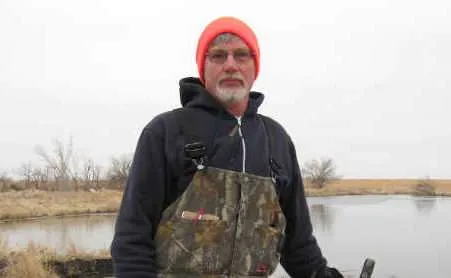Several years ago when I began trapping beavers, one particular bend in a stream taught me a valuable lesson about wildlife sign. It was along a rutted dirt road somewhere between the middle of nowhere and the end of the line where an old bridge spanned the stream as it meandered through a sand hills pasture thick with cedars. Cottonwoods of various sizes grew near the stream, and from the truck I could see that several of the bigger ones had been severely gnawed by beavers. The owner had told me of fresh beaver chewings along this creek, but I hadn’t expected the amount I was seeing. I donned chest waders and shoulder length gloves, and with traps and stakes in hand headed for the stream. In a sharp bend ahead of me a scraggly brushy tree had toppled from the high bank above and lay intact in a deep pool in the creek below. I was pretty sure its thick mass of roots sheltered a beaver den dug deeply into the mud beneath, because cleanly stripped sticks floated around the edges of the pool, and pine boughs lay on the banks nearby. The water around the uprooted tree was too deep to wade into, so I went a ways in both directions from the den, set four traps and headed home with visions of 4 beavers the next day. After all, given the amount of fresh sign, beavers had to be thick in this creek… or were they? Four days later, I had only1 large beaver to show for my enthusiasm. That year, I learned a valuable lesson about beaver trapping that I had long ago learned about hunting and trapping other species; the amount of sign left by our four- legged quarry isn’t always a true picture of the number of critters.
I remember another safari I once took after our only good tracking snow of that winter. I headed for the woods to see what the fresh snow could show me. My first stop was a 30 acre soybean stubble field nestled along the river and surrounded by hedge trees on all sides. There were quite literally thousands of deer tracks criss-crossing that field! It looked like an elementary school playground after recess. Now I know there are lots of deer there, but are there thousands? Look under any bridge that crosses a stream and you’ll find literally hundreds of raccoon tracks in the mud. There are lots of raccoons in this part of Kansas, but again, do hundreds visit that bridge? I’m learning that the same is true of signs left by beavers along any waterway. Severed branches floating everywhere and chewed & toppled trees by the dozens do not mean dozens of beavers.
For starters, we need to consider that all mammals we hunt and trap have 4 legs, and 4 feet can leave a multitude of tracks in one night’s time. Secondly, animal’s lives revolve around survival, and a major part of that survival is foraging for food. Lots of steps are taken each night in pursuit of that, two- legged birds included. All of you who have watched deer browse or raccoons waddle along a stream know that they don’t stand in one place very long. Multiply that times eight hours or more and that’s a lot of tracks! If we were to freshly paint the floors and isles of our workplaces, or our kitchen floors near the refrigerator, then observe the number of shoe prints there at the end of an eight hour work shift, or the end of our day at home, we’d be amazed how many tracks just a few of us would make.
In the end, this all amounts to a few animals leaving a multitude of life-signs of various kinds. When scouting there is no better find than tracks and other signs left by our four- legged quarry. And while it is true that the more tracks and other signs you see, the more animals there are using that particular area, we just need to consider all the above when estimating wildlife numbers. So to be on the conservative side, count the tracks and divide by four! Continue to Explore Kansas outdoors.
Steve can be contacted by email at stevenrgilliland@gmail.com.




